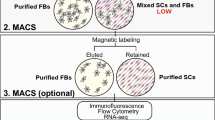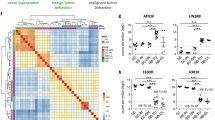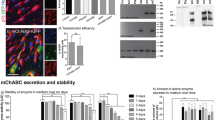Abstract
We present a fast protocol that can be used to obtain highly purified cultures of proliferating adult human and rat Schwann cells accessible for non-viral transfection methods. The use of enriched genetically modified adult Schwann cells is of interest in the context of autologous cell transplantation within nerve transplants for peripheral nerve repair. Cell preparation from pre-degenerated adult peripheral nerves is described, together with the use of melanocyte growth medium plus forskolin, fibroblast growth factor-2 (FGF-2), pituitary extract and heregulin as a selective, serum-free culture medium and a subsequent cell enrichment step (cold jet). Proliferating adult Schwann cells can be efficiently genetically modified using optimized, non-viral electroporation protocols. The protocol results in Schwann cell cultures that are more than 90–95% pure, and transfection efficiencies vary depending on the initial cell constitution from 20 to 40%. The procedure takes up to 21 d, depending on the length of the pre-degeneration period.
This is a preview of subscription content, access via your institution
Access options
Subscribe to this journal
Receive 12 print issues and online access
$259.00 per year
only $21.58 per issue
Buy this article
- Purchase on Springer Link
- Instant access to full article PDF
Prices may be subject to local taxes which are calculated during checkout



Similar content being viewed by others
References
Scarpini, E., Kreider, B.Q., Lisak, R.P. & Pleasure, D.E. Establishment of Schwann cell cultures from adult rat peripheral nerves. Exp. Neurol. 102, 167–176 (1988).
Morrissey, T.K., Kelitman, N. & Bunge, R.P. Isolation and functional characterization of Schwann cells derived from adult peripheral nerve. J. Neurosci. 11, 2433–2442 (1991).
Guenard, V., Kleitman, N., Morrissey, T.K., Bunge, R.P. & Aebischer, P. Syngeneic Schwann cells derived from adult nerves seeded in semipermeable guidance channels enhance peripheral nerve regeneration. J. Neurosci. 12, 3310–3320 (1992).
Ansselin, A.D., Corbeil, S.D. & Davey, D.F. Culture of Schwann cells from adult animals. In Vitro Cell. Dev. Biol. Anim. 31, 253–254 (1995).
Peulve, P., Laquerriere, A., Paresy, M., Hemet, J. & Tadie, M. Establishment of adult rat Schwann cell cultures: effect of b-FGF, alpha-MSH, NGF, PDGF, and TGF-beta on cell cycle. Exp. Cell Res. 214, 543–550 (1994).
Levi, A.D.O. Characterization of the technique involved in isolating Schwann cells from adult human peripheral nerve. J. Neurosci. Methods 68, 21–26 (1996).
Casella, G.T.B., Bunge, R.P. & Wood, P.M. Improved method for harvesting human Schwann cells from mature peripheral nerve and expansion in vitro . Glia 17, 327–338 (1996).
Keilhoff, G., Fansa, H., Schneider, W. & Wolf, G. In vivo predegeneration of peripheral nerves: an effective technique to obtain activated Schwann cells for nerve conduits. J. Neurosci. Methods 89, 17–24 (1999).
Keilhoff, G., Fansa, H., Smalla, K.H., Schneider, W. & Wolf, G. Neuroma: a donor-age independent source of human Schwann cells for tissue engineered nerve grafts. Neuroreport 11, 3805–3809 (2000).
Calderon-Martnez, D., Garavito, Z., Spinel, C. & Hurtado, H. Schwann cell-enriched cultures from adult human peripheral nerve: a technique combining short enzymatic dissociation and treatment with cytosine arabinoside (Ara-C). J. Neurosci. Methods 114, 1–8 (2002).
Vroemen, M. & Weidner, N. Purification of Schwann cells by selection of p75 low affinity nerve growth factor receptor expressing cells from adult peripheral nerve. J. Neurosci. Methods 124, 135–143 (2003).
Komiyama, T. et al. A novel technique to isolate adult Schwann cells for an artificial nerve conduit. J. Neurosci. Methods 122, 195–200 (2003).
Haastert, K., Mauritz, C., Matthies, C. & Grothe, C. Autologous adult human Schwann cells genetically modified to provide alternative cellular transplants in peripheral nerve regeneration. J. Neurosurg. 104, 778–786 (2006).
Mauritz, C., Grothe, C. & Haastert, K. Comparative study of cell culture and purification methods to obtain highly enriched cultures of proliferating adult rat Schwann cells. J. Neurosci. Res. 77, 453–461 (2004).
Bunge, R.P. Expanding roles for the Schwann cell: ensheathment, myelination, trophism and regeneration. Curr. Opin. Neurobiol. 3, 805–809 (1993).
Haastert, K. et al. Rat embryonic motoneurons in long-term co-culture with Schwann cells: a system to investigate motoneuron diseases on a cellular level in vitro . J. Neurosci. Methods 142, 275–284 (2005).
Jirsova, K., Sodaar, P., Mandys, V. & Bar, P.R. Cold jet: a method to obtain pure Schwann cell cultures without the need for cytotoxic, apoptosis-inducing drug treatment. J. Neurosci. Methods 78, 133–137 (1997).
Muller-Ostermeyer, F., Claus, P. & Grothe, C. Distinctive effects of rat fibroblast growth factor-2 isoforms on PC12 and Schwann cells. Growth Factors 19, 175–191 (2001).
Casella, G.T.B. et al. Density dependent regulation of human Schwann cell proliferation. Glia 30, 165–177 (2000).
Claus, P. et al. Differential intranuclear localization of fibroblast growth factor-2 isoforms and specific interaction with the survival of motoneuron protein. J. Biol. Chem. 278, 479–485 (2003).
Acknowledgements
Our studies were financially supported by the German Research Foundation (Grant 857/15-3 to C.G.), the Kogge-Stiftung für veterinärmedizinische Forschung (to K.H.) and the International Neurobionic Foundation (to C.G.).
Author information
Authors and Affiliations
Corresponding author
Ethics declarations
Competing interests
The authors declare no competing financial interests.
Rights and permissions
About this article
Cite this article
Haastert, K., Mauritz, C., Chaturvedi, S. et al. Human and rat adult Schwann cell cultures: fast and efficient enrichment and highly effective non-viral transfection protocol. Nat Protoc 2, 99–104 (2007). https://doi.org/10.1038/nprot.2006.486
Published:
Issue Date:
DOI: https://doi.org/10.1038/nprot.2006.486
This article is cited by
-
Combined effects of rat Schwann cells and 17β-estradiol in a spinal cord injury model
Metabolic Brain Disease (2018)
-
Anti-Apoptotic Effect of IGF1 on Schwann Exposed to Hyperglycemia is Mediated by Neuritin, a Novel Neurotrophic Factor
Molecular Neurobiology (2018)
-
Two factor-based reprogramming of rodent and human fibroblasts into Schwann cells
Nature Communications (2017)
-
A rapid and versatile method for the isolation, purification and cryogenic storage of Schwann cells from adult rodent nerves
Scientific Reports (2016)
Comments
By submitting a comment you agree to abide by our Terms and Community Guidelines. If you find something abusive or that does not comply with our terms or guidelines please flag it as inappropriate.



